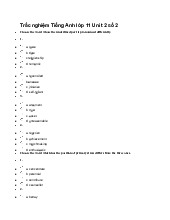





Preview text:
Giải Tiếng Anh 11 Unit 2 Communication and culture clil Everyday English Bài 1
Asking for and giving permission
(Hỏi xin và cho phép)
Listen and complete the conversation with the expressions in the box. Then practise it in pairs.
(Nghe và hoàn thành đoạn hội thoại với các cách diễn đạt trong khung. Sau đó thực hành theo cặp.)
A. Is it OK (Nó có được không?)
B. I'm afraid not (Tôi e là không)
C. Certainly (Chắc chắn)
D. can I (Tôi có thể không)
Lan: Mum (1) _____________________ go to my friend's birthday party this Saturday evening?
Lan's mother: (2)_____________________. Whose birthday is it?
Lan: It's Mai's birthday, Mum. (3) ________________ if I stay the night at her house after the party?
Lan's mother: Oh, (4)_________________. You must come back home before 10
p.m. We're going to visit your grandparents early on Sunday morning.
Lan: OK, Mum. I'll be home before 10 p.m. then. Gợi ý đáp án 1 - D 2 - C 3 - A 4 - B Bài 2
Work in pairs. Use the model in 1 to make similar conversations for these
situations. One of you is Student A, the other is Student B. Provide reasons for
not giving permission. Use the expressions below to help you.
(Làm việc theo cặp. Sử dụng mô hình trong bài 1 để thực hiện các cuộc hội thoại
tương tự cho các tình huống này. Một trong số các bạn là Học sinh A, người kia là
Học sinh B. Đưa ra lý do không cho phép. Sử dụng các cách diễn đạt bên dưới để giúp bạn.)
1. Student A is a teenager, Student B is his/her parent. Student A is asking for
permission to invite friends to a party. Student B can decide to give permission or not.
2. Student B is a teenager, Student A is his/her parent. Student B is asking for
permission to colour his/her hair. Student A can decide to give permission or not. Gợi ý đáp án
Situation 1 (Tình huống 1)
Student A: Mum, can I invite my friends to party tonight?
(Học sinh A: Mẹ ơi, con có thể mời bạn của con đến dự tiệc tối nay không?)
Student B: Of course you can.
(Học sinh B: Tất nhiên con có thể.)
Situation 2 (Tình huống 2)
Student B: Dad, do you mind if I color my hair?
(Học sinh B: Bố ơi, bố có phiền không nếu con nhuộm tóc ạ?)
Student A: I’m sorry but this is impossible.
(Học sinh A: Bố rất tiếc nhưng điều này là không thể.) Student B: Why dad?
(Học sinh B: Tại sao ạ bố?)
Student A: You know, you are still student and your school does not allow student to
color their hair. In addition, Dyeing your hair is harmful to your scalp.
(Học sinh A: Con biết đấy, con vẫn còn là học sinh và trường của con không cho phép
học sinh nhuộm tóc. Ngoài ra, nhuộm tóc còn gây hại cho da đầu của con.)
Student B: Ok dad. I won’t do it.
(Học sinh B: Vâng thưa bố. Con sẽ không làm điều đó.) Culture Bài 1
The generation gap in Asian American families
(Khoảng cách thế hệ trong các gia đình châu Á châu Mĩ)
Read the text and complete the notes. Use no more than TWO words for each gap.
(Đọc đoạn văn và hoàn thành các ghi chú. Sử dụng không quá hai từ cho mỗi khoảng trống.)
For people in most cultures, the generation gap in their family is mainly about
differences in musical tastes, career choices, and lifestyles. In Asian American
families, however, the process of adapting to American culture makes the generation gap wider.
Naturally, children of Asian American immigrants adapt to American culture much
faster than their parents. English quickly becomes their first language. They accept
American values such as individualism, freedom, honesty, and competition. They also
start to follow American traditions in their daily lives.
On the other hand, many first-generation Asian American parents fail to adapt to the
new culture. They continue to use their native language. They keep practising their
traditional lifestyle and old culture. They often try to force their children to follow
their native country's cultural values, such as the importance of family, respect for the elders and the community.
Due to their different attitudes to the new culture, Asian American children may have
cultural values different from their parents' Asian cultural values. They may not do
what their parents want them to do or what they are expected to do. As a result, Asian
American parents may fail to have their children follow the family traditional values. ASIAN AMERICAN CHILDREN FIRST-GENERATION ASIAN AMERICAN PARENTS
Adapt to American culture faster
Fail to adapt to American culture
Speak (1) __________________ as their Use their (3) __________________ first language language
Accept American values: individualism,
Practise a traditional lifestyle and their
freedom, honesty, and competition old culture
Start to follow (2) __________________ Try to force children to follow native in their daily lives
country's (4) __________________:
Importance of family respect for the elders and community Gợi ý đáp án 1 - English 2 - American 3 - native 4 - cultural values traditions ASIAN AMERICAN CHILDREN FIRST-GENERATION
(TRẺ EM MỸ GỐC Á) ASIAN AMERICAN PARENTS
( CHA MẸ NGƯỜI MỸ GỐC Á THẾ HỆ THỨ NHẤT)
Adapt to American culture faster
Fail to adapt to American culture
(Thích nghi với văn hóa Mỹ nhanh hơn) (Không thích nghi được với văn hóa Mỹ)
Speak (1) English as their first language Use their (3) native language
(Nói tiếng Anh như ngôn ngữ đầu tiên
(Sử dụng ngôn ngữ mẹ đẻ của họ) của họ)
Practise a traditional lifestyle and their
Accept American values: individualism, old culture
freedom, honesty, and competition
(Thực hành một lối sống truyền thống và
(Chấp nhận các giá trị của Mỹ: chủ
văn hóa cũ của họ)
nghĩa cá nhân, tự do, trung thực và cạnh
Try to force children to follow native tranh)
country's (4) cultural values:
Start to follow (2) American traditions Importance of family, respect for the in their daily lives elders and community
(Bắt đầu tuân theo các truyền thống của (Cố ép con cái tuân theo các giá trị văn
Mỹ trong cuộc sống hàng ngày của họ) hóa của nước bản xứ: Tầm quan trọng
của gia đình, tôn trọng người lớn tuổi và cộng đồng) Bài 2
Work in groups. Discuss the following questions.
(Làm việc theo nhóm. Thảo luận câu hỏi sau.)
Do you think your family would experience the same generation gap if you move a Western country? Why/Why not?
(Bạn có nghĩ rằng gia đình bạn sẽ trải qua khoảng cách thế hệ giống nhau nếu bạn
chuyển đến một quốc gia phương Tây không? Tại sao? Tại sao không?) Gợi ý đáp án
Yes I do. Because our way of life, culture, and thoughts are different from Westerners.
A typical example of Western parents who always want their children to be
independent and let them decide their own direction. On the other hand, our parents
always want us follow their step.




